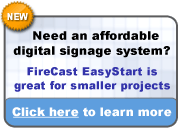As MediaPost noted yesterday, Zoom Media, who has traditionally haunted nightlife venues and recently purchased Alloy Media + Marketing's Insite division to grab a footprint in about 2,000 bars across the US, just announced that they purchased ClubCom, which operates displays in 1,600 health clubs and gyms in the US, UK, Germany, Japan and Australia. The article notes:
1. Zoom determined that advertisers were less interested in the activity taking place at the venue, and more about the people who frequent them (and how often). Otherwise, how else would you explain a bar network and a gym network merging?
2. ClubCom was either in pretty bad shape, or else Zoom was much better capitalized than anybody thought. Buying an established network of a few thousand screens isn't cheap, if just for the asset costs alone, so ClubCom was either in dire straights due to bad management, or had a lot of unused cash sitting around and felt it could be aggressive. I couldn't say which it was without talking to somebody about it.
So Zoom is certainly doing its part to speed up the consolidation of the network side of our industry. Who's next?
Tags: digital signage, out-of-home advertising, dooh
That means Zoom now operates 16,000 digital screens in 2,250 venues, in addition to another 55,000 static billboards distributed across a total of 8,500 venues. The terms of the deal were not disclosed. Announcing the acquisition, Zoom touted the high concentration of 18-34-year-old adults, particularly males, in out-of-home "lifestyle" venues like bars, nightclubs, restaurants and fitness clubs, as well as the large amount of time spent at these venues. On average, the typical dwell time for all three venues is two to three hours per visit, with at least one visit per week.While the new direction of the company is as of yet a bit unclear, I might speculate that:
1. Zoom determined that advertisers were less interested in the activity taking place at the venue, and more about the people who frequent them (and how often). Otherwise, how else would you explain a bar network and a gym network merging?
2. ClubCom was either in pretty bad shape, or else Zoom was much better capitalized than anybody thought. Buying an established network of a few thousand screens isn't cheap, if just for the asset costs alone, so ClubCom was either in dire straights due to bad management, or had a lot of unused cash sitting around and felt it could be aggressive. I couldn't say which it was without talking to somebody about it.
So Zoom is certainly doing its part to speed up the consolidation of the network side of our industry. Who's next?
Tags: digital signage, out-of-home advertising, dooh


 Subscribe to this blog
Subscribe to this blog Follow Bill Gerba on Twitter
Follow Bill Gerba on Twitter
1 comment:
as it has been pointed out, relationships with advertisers is often the key to success in advertising networks. zoom has that in spades. they know how to design, sell and manage in static. moving to digital just translates their core value to this new medium.
besides, buying in a down market is wise IMO.
Post a Comment